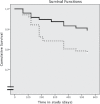Cognitive behavioral therapy for subjects at ultrahigh risk for developing psychosis: a randomized controlled clinical trial
- PMID: 22941746
- PMCID: PMC3494039
- DOI: 10.1093/schbul/sbs105
Cognitive behavioral therapy for subjects at ultrahigh risk for developing psychosis: a randomized controlled clinical trial
Abstract
Background: Evidence for the effectiveness of treatments for subjects at ultrahigh risk (UHR) for developing psychosis remains inconclusive.
Objective: A new cognitive behavioral intervention specifically targeted at cognitive biases (ie, Cognitive Behavioral Therapy [CBT] for UHR patients plus treatment as usual [TAU] called CBTuhr) is compared with TAU in a group of young help-seeking UHR subjects.
Methods: A total of 201 patients were recruited at 4 sites and randomized. In most cases, CBTuhr was an add-on therapy because most people were seeking help for a comorbid disorder. The CBT was provided for 6 months, and the follow-up period was 18 months.
Results: In the CBTuhr condition, 10 patients transitioned to psychosis compared with 22 in the TAU condition (χ(2) (1) = 5.575, P = .03). The number needed to treat (NNT) was 9 (95% confidence interval [CI]: 4.7-89.9). At 18-month follow-up the CBTuhr group was significantly more often remitted from an at-risk mental state, with a NNT of 7 (95% CI: 3.7-71.2). Intention-to-treat analysis, including 5 violations against exclusion criteria, showed a statistical tendency (χ(2) (1) = 3.338, P = .06).
Conclusions: Compared with TAU, this new CBT (focusing on normalization and awareness of cognitive biases) showed a favorable effect on the transition to psychosis and reduction of subclinical psychotic symptoms in subjects at UHR to develop psychosis.
Figures


References
-
- Yung AR, Phillips LJ, McGorry PD, et al. Prediction of psychosis. A step towards indicated prevention of schizophrenia. Br J Psychiatry Suppl 1998. 172 14–20 - PubMed
-
- Yung AR, Yuen HP, McGorry PD, et al. Mapping the onset of psychosis: the Comprehensive Assessment of At-Risk Mental States. Aust N Z J Psychiatry 2005. 39 964–971 - PubMed
-
- Yung AR, Phillips LJ, Yuen HP, et al. Psychosis prediction: 12-month follow up of a high-risk (“prodromal”) group. Schizophr Res 2003. 60 21–32 - PubMed
-
- McGorry PD, Nelson B, Amminger GP, et al. Intervention in individuals at ultra-high risk for psychosis: a review and future directions. J Clin Psychiatry 2009. 70 1206–1212 - PubMed
Publication types
MeSH terms
Associated data
LinkOut - more resources
Full Text Sources
Medical

